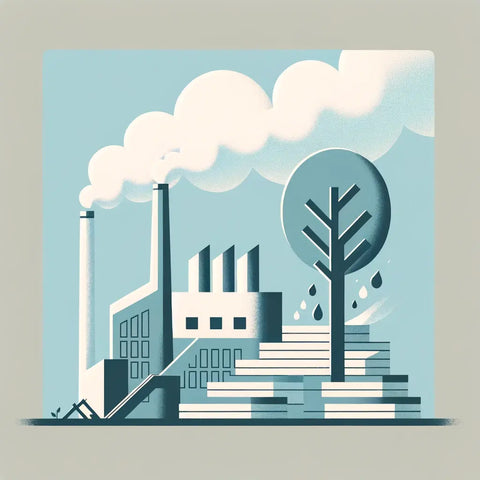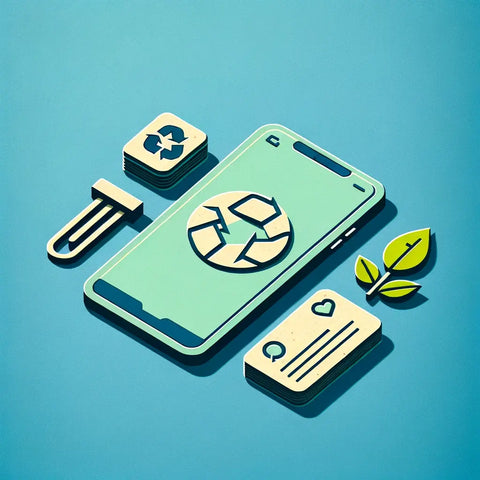Why Are Paper Business Cards Bad For The Environment?

Paper business cards have been a long-standing tradition in the professional world, but it's important to consider their environmental impact. The production and disposal of paper contribute significantly to various environmental issues.
By examining statistics and facts surrounding paper consumption, waste generation, and the specific impact of paper business cards, we can gain insights into their environmental implications.
Exploring alternatives to traditional paper business cards can provide sustainable solutions. Let's delve into the environmental impact of paper business cards and explore the data and facts that shed light on their effects on deforestation, water pollution, climate change, and the benefits of using sustainable alternatives.
Key takeaways:
- Paper production leads to deforestation: The production of paper business cards contributes to deforestation, with significant numbers of trees being cut down each year.
- Paper production consumes vast amounts of water: The water required to produce paper business cards considerably impacts water resources.
- Paper business cards contribute to climate change: The carbon footprint associated with paper production and disposal, including releasing greenhouse gases and energy usage, contributes to climate change.
The Environmental Impact of Paper Business Cards

The environmental impact of paper business cards is a concerning issue that can be addressed by considering alternative options and implementing sustainable practices.
Deforestation caused by paper production for business cards contributes to biodiversity loss and carbon storage. Additionally, the manufacturing process of paper cards consumes significant amounts of energy and water. Moreover, after their short lifespan, paper business cards often end up in landfills, further exacerbating the growing waste problem.
Furthermore, both the production and disposal of paper cards release harmful chemicals into the environment. To mitigate these issues, sustainable alternatives such as switching to digital business cards or using eco-friendly materials like recycled paper can significantly reduce the environmental impact.
Statistics on Paper Consumption

According to statistics on paper consumption, the average person in the United States uses approximately 700 pounds of paper per year. Furthermore, the demand for paper worldwide has been steadily increasing, with China emerging as the largest consumer. Notably, the paper industry significantly contributes to deforestation and greenhouse gas emissions.
| Statistic | Value |
| Average paper usage per person in the US | 700 pounds per year |
| Global paper demand | Increasing |
| Largest paper consumer | China |
| Environmental impact | Deforestation, greenhouse gas emissions |
How many trees are cut down for paper production?
Approximately 15 billion trees are cut down annually for paper production, resulting in extensive deforestation. This alarming rate of deforestation leads to habitat loss, climate change, and biodiversity depletion and raises the question of how many trees are being sacrificed for paper. However, we can effectively reduce this environmental impact by embracing sustainable alternatives to paper.
How much water is used in paper production?
Water usage in paper production is dependent on several factors, including the type of paper, production methods, and recycling practices. It requires approximately 10 liters of water to manufacture a single A4 sheet of paper. However, it is crucial to understand that this estimation may vary significantly across various paper mills and regions.
What is the carbon footprint of paper production?
The carbon footprint of paper production is significant due to the energy-intensive processes involved, such as harvesting trees, transportation, and manufacturing. This includes greenhouse gas emissions from fossil fuel use, particularly in the pulping and drying phases, which contribute to increased atmospheric carbon dioxide levels. Therefore, it is important to understand the carbon footprint of paper production.
Facts about Paper Waste

- Over 15 billion trees are cut down each year for paper production.
- In the US, paper waste accounts for 25% of landfill waste.
- The production of one ton of paper creates around 2,278 pounds of solid waste.
- About 50% of office waste is paper and cardboard.
- Paper can take up to 5 months to decompose in landfills.
How much paper waste is generated each year?
Annually, a staggering amount of paper waste is generated. The exact figures vary, but estimates indicate that millions of tons of paper waste are generated globally. This excessive waste puts a strain on our forests and contributes to environmental degradation.
How long does it take for paper to decompose?
Paper can decompose anywhere from several weeks to several months, depending on factors such as thickness, humidity, and temperature. On average, it takes about 2 to 5 months for paper to fully decompose. To reduce the environmental impact, consider using digital business cards or opting for sustainable alternatives like recycled paper or biodegradable materials.
The Effect of Paper Business Cards

- Paper waste: The use of paper business cards contributes to deforestation and environmental degradation.
- Carbon emissions: The production and transportation of paper cards result in significant greenhouse gas emissions.
- Resource consumption: Paper production requires large amounts of water and energy, further straining natural resources.
- Limited lifespan: Paper cards are often discarded shortly after being exchanged, leading to unnecessary waste.
We wrote a blog post about the nine shocking truths of traditional paper business cards if you'd like to learn more.
What is the impact of paper business cards on deforestation?
The impact of paper business cards on deforestation is a topic of concern. Every year, over 7 million trees are used to manufacture paper for business cards, causing harm to natural habitats. However, by adopting digital business cards, we can play a part in minimizing deforestation and safeguarding our forests for future generations.
How do paper business cards contribute to water pollution?
Paper business cards can contribute to water pollution through the manufacturing process. The production of paper involves the use of water, and the chemicals and dyes used in the process can contaminate water sources. Improper disposal of paper cards can lead to water pollution when they end up in water bodies. Consider using digital business cards as a sustainable alternative to reduce water pollution.
What role do paper business cards play in climate change?
Paper business cards contribute to climate change through the process of paper production. Trees, which absorb carbon dioxide, are cut down, reducing the planet's natural ability to mitigate greenhouse gases.
Additionally, paper production releases carbon emissions, further contributing to climate change. To reduce this impact, sustainable alternatives to paper business cards, such as digital cards, can be utilized.
Alternatives to Paper Business Cards

There are a variety of eco-friendly alternatives to paper business cards:
- Electronic business cards: Share contact information digitally through email, text, or QR codes. We have created a blog post explaining the advantages of using digital business cards with QR codes.
- Biodegradable cards: Utilize cards made from materials such as bamboo, hemp, or seed paper that naturally break down.
- Reusable cards: Invest in durable cards made from materials like metal or wood that can be utilized repeatedly.
- Virtual cards: Generate a digital business card using platforms such as Wave or other providers.
Are digital business cards more environmentally friendly?
- Reduction in paper waste: Digital business cards eliminate the need for physical cards, reducing paper consumption and waste.
- Sustainable materials: Digital cards can be created using eco-friendly materials, such as recycled or renewable resources.
- Lower carbon footprint: With no printing or transportation involved, digital cards have a smaller carbon footprint compared to paper cards.
- Infinite reuse: Digital cards can be easily updated, shared, and reused without the need for additional resources.
- Reduced deforestation: By not contributing to the demand for paper, digital business cards help preserve forests and mitigate deforestation.
What are the benefits of using sustainable alternatives to paper?
- The benefits of using sustainable alternatives to paper include being eco-friendly, as they reduce paper waste and deforestation.
- Additionally, they are cost-effective, eliminating the need for printing and distributing paper cards.
- Moreover, they offer convenience, allowing you to easily update and share contact information without reprinting cards.
- Furthermore, sustainable alternatives are efficient, saving time by eliminating the need to manually exchange business cards.
- Lastly, embracing eco-friendly practices showcases your commitment to sustainability and innovation, enhancing your professional image.
Some Facts about the Environmental Impact of Paper Business Cards:
- ✅ Approximately 10 billion business cards are printed each year, but 88% of them are discarded within a week.
- ✅ Shockingly, 7.2 million trees are cut down annually to produce the paper for these business cards.
- ✅ In response to the environmental impact, there is a shift towards digital business cards in today's digital world.
- ✅ Instead of collecting paper business cards, people can now scan a QR code on their phones to receive digital business cards.
- ✅ Paper business cards are becoming obsolete due to the advancements in technology and the rise of digital transformation.
Frequently Asked Questions
What is the environmental impact of paper business cards?
Paper business cards have a significant environmental impact. Approximately 10 billion business cards are printed each year, destroying around 7.2 million trees annually. Paper production, including business cards, also results in high energy consumption, water consumption, and waste creation. Moreover, most paper business cards end up in the trash within a week, further contributing to environmental degradation.
How is digital transformation affecting the usage of paper business cards?
Digital transformation is driving the move away from traditional paper business cards. In today's digital world, people are replacing paper cards with digital ones. With the advancements in technology, free digital business cards are becoming more popular due to their higher usage rates and the ease of sharing them online. This shift towards digitalization is being embraced by companies, with the management team also adopting digital business cards.
What are the advantages of using digital business cards over paper ones?
Digital business cards offer numerous advantages over traditional paper cards. Firstly, they eliminate the need for printing, reducing the destruction of trees and resulting in zero waste. Secondly, digital cards are saved directly to the device, making them less likely to be lost or forgotten. Additionally, digital business cards provide an interactive platform, encouraging better utilization and engagement. They are also easier to share online, catering to the convenience of our increasingly digital world.
Why are paper business cards becoming obsolete?
Paper business cards are becoming obsolete due to the evolution of business practices and the rise of digital interactions. Traditional paper cards have an efficacy problem, with only 2% of people actually using the information on them. In contrast, digital cards offer a more efficient and eco-friendly solution. They eliminate waste, are easier to manage and share, and encourage meaningful connections through their digital platform.
What are the environmental benefits of using digital business cards?
Digital business cards have several environmental benefits compared to their paper counterparts. By switching to digital, we can reduce the potential loss of nearly 6 million trees annually, as well as prevent habitat destruction and deforestation caused by the groundwood process. Digital cards also contribute to sustainable forestry practices and help mitigate climate change by preserving trees, which store significant amounts of carbon.
How does Wave's digital business cards contribute to environmental sustainability?
Wave Digital Business Cards provide an innovative, efficient, and eco-friendly alternative to traditional paper business cards. By adopting a digital approach, Wave eliminates the waste and provides a greener way to share contact information. The company is committed to reducing its carbon footprint by following sustainable practices. By choosing Wave Digital Business Cards, individuals and organizations can help in the preservation of trees, reduction of waste, and overall environmental protection.
About The Author






